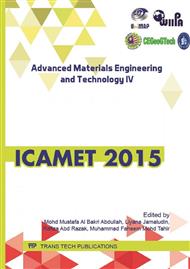p.327
p.331
p.337
p.342
p.347
p.352
p.358
p.363
p.367
Leachability of Heavy Metals from Steel Mill Sludge Incorporated in Fired Clay Brick
Abstract:
The reuse of sludge in clay brick material is a long-term approach to sludge disposal for economic and environmental sustainability. In this study, steel mill sludge collected from Kluang, Johor was used to be investigated to replace clay as brick material. The raw material has been characterized using X Ray Fluorescent (XRF) analysis. The optimum moisture content (OMC) and maximum dry density (MDD) of the soil used was performed by using Standard Proctor Compaction Test in order to verify percentages of water used during brick manufacturing. Brick were manufactured into different percentages which are control brick (0%) and steel mill sludge brick with 5%, 10% and 15% of steel mill sludge waste. Manufactured brick was dried and fired in a furnace at 1050 °C. The results showed that zinc (Zn) and copper (Cu) are the higher heavy metal concentrations detected in steel mill sludge. Meanwhile, leachability test showed that heavy metals leached from steel mill sludge brick are low under permissible limit and complied with United States Environmental Protection Agency (USEPA).
Info:
Periodical:
Pages:
347-351
Citation:
Online since:
May 2016
Keywords:
Price:
Сopyright:
© 2016 Trans Tech Publications Ltd. All Rights Reserved
Share:
Citation:


